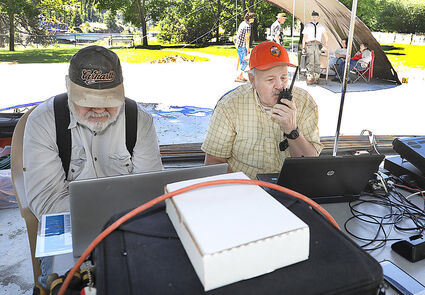Ham radio operators hone skills
June 30, 2022

Ed Moreth
MAKING CONTACT – Kevin Kerr of Plains makes contact with a ham radio operator in Florida during Field Day at Power Park in Thompson Falls while Jim Fey works on a digital contact.
To ham it up was all part of the game for a group of people who spent the day in Thompson Falls hoping to talk to as many people as possible – and distance was not an issue.
Nearly a dozen members of the Clark Fork Amateur Radio Club set up their ham radios at Power Park on Saturday as part of a national event put on by American Radio Relay League (ARRL) called "Field Day." Five club members set up their ham radios in the park and made as many contacts as possible. The primary goal of Field Day is to show that communications by ham radio can be achieved during a natural disaster.
"It went great. It gave us the opportunity to get set up in a remote location and not use commercial power, like cell phones or landlines," said Jim Fey, president of the Clark Fork Amateur Radio Club, which began six years ago with a handful of members. The ARRL has conducted a Field Day each year since 1933, except during World War II, according to Lynn Lanzoni, the club's vice president and a ham radio operator for the last six years.
"The fact that we bring our radios out of the house and use something other than commercial power prepares us to go anywhere to provide communications," said Lanzoni, who was a radio operator in the Army's Special Forces in the 1960s. "I learned a couple of things that I need to adjust for emergency deployment, found new members, and enjoyed being around my ham friends all day," added Lanzoni.
The club started setting up equipment at 10 a.m. With their radios on portable tables and hooked up to batteries, operators used a line with a weight on the end to toss their lines for antennas 15-20 feet up over tree branches. Fey instead utilized an Army surplus antenna called a "jungle tower," which he raised to 20 feet, though he said he could go to a height of 50 feet.

The ARRL's purpose for Field Day was to demonstrate that in times of disaster, ham radios could be used as a communication platform when electrical power, which now includes cell phones, are unworkable. "The whole point of Field Day is to show and practice we can communicate in a national disaster," said Fey. The Plains resident added that people and the government depend highly on power, and one way to get around a power deficiency in times of catastrophe is to use amateur radio operators – "hams" – to serve in a communication capacity. Field days show the local government and residents that ham operators can be used to deploy ambulances, police, fire trucks, and other emergency services to scenes. He said that the Federal Emergency Management Agency (FEMA), the Red Cross and other agencies have memorandum of understandings with the ARRL in the event of an emergency.
The Field Day was established to demonstrate that ham radios can be utilized in emergency situations and serve as a public relations tool to the public. It's also a competition between clubs, which make as many ham radio contacts as possible in a 24-hour period. The Clark Fork Amateur Radio Club, however, went only until 5 p.m. Saturday.
"Our club is mostly seniors. We like to go home and sleep in our beds at night," said Delta Clemons-Jackson, who is a ham radio operator with her husband, Bob Jackson. Delta has been a ham for 10 years, but her husband has had his license for 58 years and belonged to a club in California prior to moving to Hot Springs. "We're having fun socializing with our radio friends. Camaraderie is a big part of this," said Delta.
There are presently 25 members in the Clark Fork Amateur Radio Club from Plains, Hot Springs, Trout Creek, and Thompson Falls. Members didn't participate in Field Day the first year, but have every year since then.
Ham radios operate on a radio wave spectrum with a variety of frequencies, and how clear a signal is depends on atmospheric conditions. The operators on Saturday demonstrated the different types of ham radio: voice, digital and continuous wave, a form of Morse Code. Costs for an amateur radio setup can run as low as $35 for a handheld radio and go into the thousands, said Lanzoni, a Thompson Falls resident. Lanzoni and Fey held a study session and testing period for ham operator licenses the prior week in Plains. Licenses, which are controlled by the FCC, come in three levels. A technician is the entry level, followed by general and then extra at the top. Thirteen people from Noxon, Hot Springs, St. Ignatius, and Polson tested, but only 10 passed, said Fey. Six people updated their license to the general class. A license is valid for 10 years.
The clubs gain points on Field Day by the number of contacts they make and the number of members who operate their radios. When a contact is made, the operator gets the other's call sign and finds out what section of the country they're in. Fey said the club had around 300 contacts, counting the 200 that Fey got with his digital system.
"If we would have set up all night, we probably would have got 2,000 contacts and more points, but it's not adding to what we were trying to do and that's setting up and communicating," said Fey, a ham for 28 years in Plains and in California. Fey had contact with operators from Montana to Florida. He shared a table with Kevin Kerr of Plains, who had a handful of contacts by voice, including one in Florida and another in Texas. Lanzoni said they won't know for a couple of months how many points the club received.
Bill Subda of Hot Springs made 20 voice contacts from South Dakota to West Virginia. Subda said he's been playing with radios since age 11 when he had a Citizens Band radio. He's been a licensed ham operator since 1990 and joined the local club three years ago. He gets on the radio every morning with a group of men from Troy and Helena to talk. "It's just like chatting in a diner," said the 72-year-old Subda.
Dewey Duffel of Thompson Falls had his system set up all day Saturday, using voice and continuous wave. Duffel, who used radio in the Army, has been a ham since around 1963 and has been with the club for two years.
"My main interest is providing emergency communications to the community," said Lanzoni, who added that Field Day is a social event, an opportunity to practice emergency communications in the field, an informal contest, and an open house to the public. Fey believes that between 25-30 people from the community stopped by to talk with the hams, including a couple that might be interested in becoming amateur radio operators. Anyone interested in joining the Clark Fork Amateur Radio Club can go to the website cfvarc.org. The club meets at the Plains Alliance Church, 505 5th St., on the first Thursday of the month at 7 p.m. The next meeting is July 7.



Reader Comments(0)